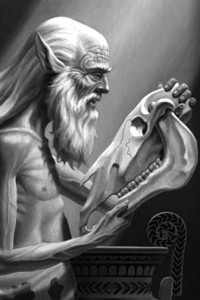Gemma Files: The Sex and Death Show
 Gemma Files was born in London but grew up in Toronto. Files began publishing her short horror fiction in the early ’90s with ‘‘Fly-by-Night’’ (1993) and ‘‘Mouthful of Pins’’ (1994). She has published more than 30 stories, notably International Horror Guild Award winner ‘‘The Emperor’s Old Bones’’ (1999), and Shirley Jackson Award finalists ‘‘each thing i show you is a piece of my death’’ (2009, with Stephen J. Barringer) and ‘‘The Jacaranda Smile’’ (2009). Her stories have been gathered in chapbook The Narrow World (2001) and full-length collections Kissing Carrion (2003) and The Worm in Every Heart (2004). First novel A Book of Tongues (2010) was a Stoker finalist, and began the Hexslinger series of dark fantasy Westerns, which continues with A Rope of Thorns (2011) and the forthcoming A Tree of Bones (2012).Files lives in Toronto with her husband Stephen J. Barringer, married 2002, and their son.
Gemma Files was born in London but grew up in Toronto. Files began publishing her short horror fiction in the early ’90s with ‘‘Fly-by-Night’’ (1993) and ‘‘Mouthful of Pins’’ (1994). She has published more than 30 stories, notably International Horror Guild Award winner ‘‘The Emperor’s Old Bones’’ (1999), and Shirley Jackson Award finalists ‘‘each thing i show you is a piece of my death’’ (2009, with Stephen J. Barringer) and ‘‘The Jacaranda Smile’’ (2009). Her stories have been gathered in chapbook The Narrow World (2001) and full-length collections Kissing Carrion (2003) and The Worm in Every Heart (2004). First novel A Book of Tongues (2010) was a Stoker finalist, and began the Hexslinger series of dark fantasy Westerns, which continues with A Rope of Thorns (2011) and the forthcoming A Tree of Bones (2012).Files lives in Toronto with her husband Stephen J. Barringer, married 2002, and their son.
Site: The Gemma Files
‘‘I started writing on the job. I wrote a couple of really terrible screenplays, and eventually I wrote the first short story I ever sold, ‘Mouthful of Pins’. I wrote that entirely on the job. That was the beginning of me selling stuff on the side while reviewing some for the paper. When the person who’d done film reviewing there was moved to another section, the reviews editor said, ‘Gemma, I hear you like horror films, weird films, independent stuff.’ So that was pretty much my slot. As I was doing that, I started writing – and placing – more and more short stories, and to a range of venues.
 ‘‘After a few years of this, I placed a collection with Prime Books. I met Sean Wallace at the World Horror Con in 2000, the year my story ‘The Emperor’s Old Bones’ won an International Horror Guild Award. I’d been going to Ad Astra in Toronto for years and years, but this was the moment where I began moving over into the professional side of things, realizing the people who I’d been reading for years had actually been reading me. Till then, I didn’t realize I had any kind of footprint in this world at all.”
‘‘After a few years of this, I placed a collection with Prime Books. I met Sean Wallace at the World Horror Con in 2000, the year my story ‘The Emperor’s Old Bones’ won an International Horror Guild Award. I’d been going to Ad Astra in Toronto for years and years, but this was the moment where I began moving over into the professional side of things, realizing the people who I’d been reading for years had actually been reading me. Till then, I didn’t realize I had any kind of footprint in this world at all.”
…
‘‘I have always had an urge towards the horrific. Often I say that horror is a ghetto inside a ghetto inside a ghetto, in terms of genre. There are science fiction people who like fantasy, and fantasy people who like science fiction, but there are not a lot of fantasy or science fiction people who like horror. On the other hand, there are horror people who like both science fiction and fantasy, and I’m one of them. (I don’t love all of it.) But horror is the place where people won’t go, the place where suddenly things aren’t good any more.
‘‘I think a lot of it has to do with the fact that people always think of horror as a very limited spectrum. When I was around 17 years old and telling people I wanted to write horror movies, they would say ‘Oh, like Friday the 13th? Ha ha.’ And I’d go, ‘No. Like Hellraiser.’ They had no idea what the difference was.”
…
‘‘I realized that I could take elements of stuff I was already writing and mix that in with my original fiction, just like Naomi Novik’s Temeraire series is Master and Commander with dragons. I made a few calculations, and then it all started to fall into place. Everything began to change from there, and I just started writing what would become A Book of Tongues. By April I had seven chapters and an outline.”
…
 ‘‘My books have a lot of sex, but that makes sense – I’m a slasher. I will never play this down: it is part of my sexuality. Since I was a little girl, I’ve been interested in the idea of two guys together. Why? I do not know. But I would never have believed, when I was 18 and trying to explain this to people and they would say, ‘What? You like what?’ that 20 years later slash would be a joke, a trope… that it would be so well known as to have massive online communities writing about it. Men have always liked lesbians, but I don’t think it’s absolutely the same thing. I do think that women go out of their way to try to figure out the psychology. Then again, there are a lot of gay guys who are offended by the entire slash phenomenon and feel like, ‘Excuse me, I’m not your poseable sexbot.’ All tables turn. But that’s why there is so much sex in the first book, because I was writing it for me.
‘‘My books have a lot of sex, but that makes sense – I’m a slasher. I will never play this down: it is part of my sexuality. Since I was a little girl, I’ve been interested in the idea of two guys together. Why? I do not know. But I would never have believed, when I was 18 and trying to explain this to people and they would say, ‘What? You like what?’ that 20 years later slash would be a joke, a trope… that it would be so well known as to have massive online communities writing about it. Men have always liked lesbians, but I don’t think it’s absolutely the same thing. I do think that women go out of their way to try to figure out the psychology. Then again, there are a lot of gay guys who are offended by the entire slash phenomenon and feel like, ‘Excuse me, I’m not your poseable sexbot.’ All tables turn. But that’s why there is so much sex in the first book, because I was writing it for me.
‘‘I do get response from the gay community, most of which has been positive. Queer Fear anthology series editor and fellow CZP writer Michael Rowe has been hugely supportive of me throughout my whole career. Rue Morgue did an article on queer horror and mentioned me, which was amazing. But I can never get away from the fact that I am a straight, white, cisgender woman with marriage privilege and mother privilege. It’s very easy for me to write what I write and then come back to my white-bread world. Intersectionality can be a good thing as well as a bad thing, though, and I think it happens more often than people like to think. So there is a part of me that wants to always be up-front about my reasons for how I write, which are very fetishistic, but at the same time, I really do believe in inclusiveness. I believe we deserve a culture where someone can open up a book and see two dudes kissing and say, ‘Yay!’ And yes, terrible things happen to my characters, but not because they are gay – simply because they are people.’’


 Excerpts from the interview:
Excerpts from the interview:



Looking forward to the rest of the interview!
Pingback:Most recent How To Publish A Horror Story News